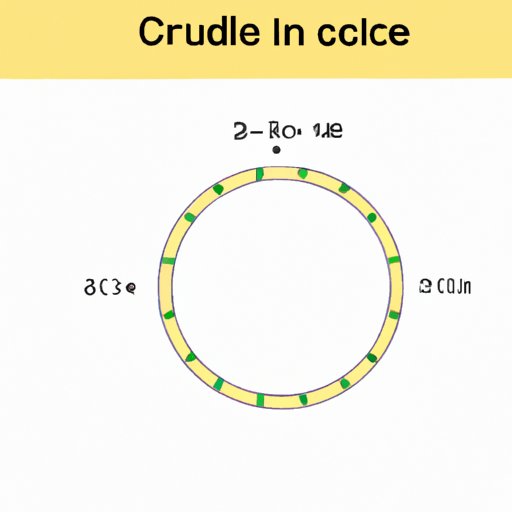
I. Introduction
Have you ever needed to find the area of a circle with only the diameter given? It can be a tricky problem to solve, but we’re here to help. In this article, we’ll explore the simplest way to calculate the area of a circle using diameter and provide you with step-by-step guidance along the way. We’ll also discuss why understanding circle math is essential and provide you with tips and tricks to solve circle problems.
II. The Simplest Way to Find the Area of a Circle Using Diameter
The formula for finding the area of a circle is A = πr^2. The radius of a circle is half of its diameter, so we can substitute the diameter into the formula using this relationship: r = d/2. Doing this creates a simpler formula for finding the area of a circle with the diameter: A = π (d/2)^2 = πd^2/4.
III. A Step-By-Step Guide to Calculating Circle Area with Just the Diameter
Let’s put the formula from section II into practice with an example problem. Suppose the diameter of a circle is 10cm. How do we find its area?
- Start by plugging in the diameter value into the formula: A = πd^2/4.
- Next, square the diameter: A = π(10cm)^2/4 = 78.5cm^2.
- Round the answer to the appropriate number of significant figures, if necessary.
That’s it! By using the formula we derived in section II, we’ve found the area of the circle.
IV. Mastering Circle Math: How to Use Diameter to Find the Area of a Circle
While there are other ways to calculate the area of a circle (such as using the radius or circumference), using diameter can be advantageous when only the diameter is given. Additionally, diameter is sometimes the only measurement that is relevant to a specific problem (e.g. distance between two points on a circular object). Here’s another example:
Suppose you need to buy a circular rug for a room with a diameter of 8ft. To determine how much rug you need, you’ll need to find the area of the circle. By using the formula A = πd^2/4, you can easily calculate the area of the rug.
V. Quick and Easy: How to Find the Area of a Circle Using Diameter
Now that we’ve learned the formula, let’s break it down into a simple, quick method you can use.
To find the area of a circle with diameter d, just multiply d^2 by π/4. This shortcut formula is derived from the formula we learned earlier: A = πd^2/4. So, A = (π/4) * d^2.
VI. Diameter to Area: The Ultimate Guide to Circle Math
Circle math is crucial to many fields, including engineering, physics, architecture, and more. Understanding how to calculate circle properties can help solve real-world problems. Here are a few examples:
- Calculating the area of a circular parking lot to determine how many spaces can fit.
- Designing a circular pool and calculating how much water it can hold.
- Calculating the distance around a circular wheel to determine the speed of a vehicle.
To become a master of circle math, practice and repetition are key. Try solving increasingly complex problems to challenge your understanding and build problem-solving skills.
VII. From Diameter to Area: Tips and Tricks to Solve Circle Problems
When solving circle problems, it’s important to pay close attention to the units of measurement to ensure that your final answer is consistent with the given units.
Another common mistake is forgetting to square the diameter before multiplying by π/4. Make sure you check your calculations and review the formulas before submitting your final answer.
VIII. Conclusion
To summarize, finding the area of a circle with diameter is a common problem that can be solved easily using the formula A = πd^2/4. We’ve also provided a quick method for this formula and discussed why understanding circle math is crucial. Remember to practice, pay attention to units, and review formulas when solving circle problems.




